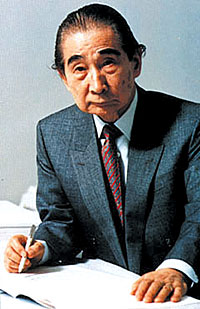 Then the UN's Burmese Secretary General U Thant visited Lumbini in 1967, he was emotionally moved. As a devout Buddhist, he was spiritually uplifted by being in the nativity site but also sad to see the desolation of the place near the Nepal-India border.
Then the UN's Burmese Secretary General U Thant visited Lumbini in 1967, he was emotionally moved. As a devout Buddhist, he was spiritually uplifted by being in the nativity site but also sad to see the desolation of the place near the Nepal-India border. On returning to New York, he set the ball rolling on developing Lumbini as an international peace site. A special UN committee was set up to push the plan and with money from UNDP a renowned Japanese architect, Kenzo Tange, was hired to draw up a masterplan for Lumbini's development. Tange took up the work passionately, visiting Lumbini several times and completed his work in 1978. His plan for Lumbini's sacred zones and its surroundings was supposed have been finished by 1989.
Tange died last week, at the age of 91, with much of his Lumbini masterplan unfinished. When the UN hired Tange, it reflected U Thant's grand vision and dream for Lumbini-he had chosen the architect who designed the Hiroshima peace memorial at Ground Zero of the first wartime use of the atomic bomb in 1945. Kenzo Tange was the most influential figure in post-war Japanese architecture and was profoundly influenced by the work of Le Corbusier. In turn, Tange's hugely impressive body of work was to influence, indeed dominate, that of a younger generation of brilliant young Japanese architects.
If Tange began by imitating the late-flowering, sculptural concrete designs of the Swiss-French genius, he went on to create a body of internationally recognised work that was very much his own, fusing traditional Japanese forms with the very latest in structural daring. Because of his penchant for raw concrete and megastructures, Tange as well as his disciples in Britain and elsewhere came to be known as 'brutalists'.
His finest buildings include the twin arena of the 1964 Tokyo Olympics, the Yamanashi press and broadcasting centre at Kofu (1964-67) and Hiroshima peace park and peace centre (1949-55).
Tange's plan for Lumbini is a three square mile mandala that leads in concentric circles to the sanctum sanctorum: the circular sacred garden surrounding the Mayadebi Temple. The plan includes a Monastic Zone and Lumbini Village for visitors will find lodges, restaurants, a cultural centre and tourist facilities. The eastern monastic zone was set aside for Theravada Buddhism from Burma, Thailand and Sri Lanka and a Vipassana Centre, and the western zone for Mahayana Buddhism from Tibet, China and Bhutan. Tange's plan is being followed but not all the temples and monasteries conform to the overall harmony and scale he had in mind.
Tange was involved in the replanning of the city of Hiroshima after its destruction by the atomic bomb on 6 August 1945. At the heart of the revived city, Tange built a peace centre, raised on stilt-like, Le Corbusier-style columns, faced by a monument that married ancient forms and the latest structural technology. This peacetime fusion of a traditional Haniwa tomb and a concrete parabola was very much a symbol of new Japan, resolutely looking to the future while proudly recalling the best of its pre-imperial past.


